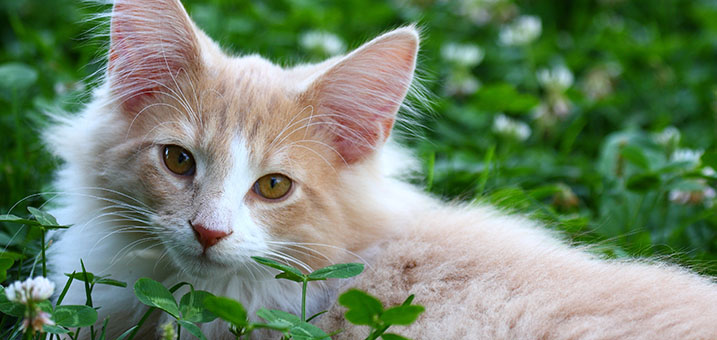Insect food and cats – an excerpt from the first study in this context.

A study by Prof. Dr. Jürgen Zentek and Prof. Dr. Nadine Paßlack on the topic:
Acceptability, tolerability and apparent nutrient digestibility of complete diets based on Hermetia illucens larval meal in cats.
Not only is insect protein worthy an economic and ecological consideration for the future, but also trials on this topic in our pets are needed.
The feces of cats were examined. Both experimental diets contained titanium oxide as an indigestible marker for calculating apparent nutrient digestibility.
Furthermore, it is to be mentioned in principle that the compatibility with the food as well as the acceptance were classified as good. It is worth mentioning here that it is more difficult to achieve a general, very good acceptability in cats. Here, too, the ingredients and the insect protein used seem to play a role.
The determination of apparent nutrient digestibilities was able to reveal a high apparent crude fat digestibility (96.0 ± 1.26% for Feed A and 92.7 ± 1.53% for Feed B). In contrast, the apparent digestibility of crude protein (77.0 ± 3.48% and 73.4 ± 3.73%) and individual amino acids was rather moderate.
Because of the rather moderate apparent crude protein digestibility, appropriate cat complete diets should always contain a sufficient safety supplement to avoid nutrient deficiencies.
In the trials, sweet potato and pea protein were specifically supplemented due to the high quality amino acid pattern.
The dry matter content of the fecal samples did not differ depending on the complete feed used.
The crude fat content of the larval meal used was between 6-9%. The intake of lauric acid had not exerted any overall emetic effect. The experimental diet had apparently shown a significantly lower crude protein digestibility than “usual” crude protein suppliers in pet nutrition.
Values given, on the other hand, refer to the pure protein suppliers. However, the apparent crude protein digestibility of dry alley foods based on different animal and plant protein sources (poultry meal, greaves meal, soy protein, corn gluten, and rice gluten), for example, averaged 82.9-88.7% in a separate study with cats (14) and was thus also higher than the values determined in the present study for the two insect meal-based feed formulations.
When considering the apparent crude protein and amino acid digestibilities, however, it must be borne in mind that the examination of fecal samples always has only limited significance here. The background is that in addition to an exogenous portion (= undigested feed protein), there is also an endogenous portion of nitrogen in the feces (7). Consequently, endogenous secretion introduces some error in determining the digestibility of feed protein. Furthermore, it must be noted that undigested protein in the small intestine (=precaecal) is partially metabolized by bacteria residing in the large intestine (21). This too leads to a certain distortion of the crude protein or amino acid digestibilities determined.
However, against the background of the limitations described above, a certain degree of caution should always be exercised when interpreting the apparent total digestibility of crude protein and amino acids.
To the authors’ knowledge, it has not yet been investigated in the cat whether it has intestinal chitinase activity for the degradation of this polysaccharide. In dogs, a low level of chitinase activity was detected in the feces, which was independent of the amount of chitin in the diet. (6)
Future developments of technological processes could start at this point to reduce the chitin content in the larval meal of Hermetia illucens and thus improve digestibility, if necessary.
In regard to possible manufacturing processes that could have an influence on the nutrient digestibility of Hermetia illucens, the age of the insects should also be mentioned.
Thus, larvae and pupae of the black soldier fly not only have different nutrient compositions (1, 3), but also differ in in vitro digestibility (3).
The rather moderate apparent protein digestibility remained without apparent clinical effect in the cats after feeding both diets based on larval meal of Hermetia illucens for 6 weeks each.
No problems in fecal consistency were observed in the cats of the present study.
In healthy dogs, a diet based on larval meal of Hermetia illucens did not affect immunological parameters compared with a diet based on lamb meal (6).
Conclusion
Acceptance and tolerability were subject to individual variations, but could be rated as good on average. The apparent crude protein digestibility of the two diets with < 80 % was lower than that of protein sources commonly used in cat nutrition.
Therefore, sufficiently high protein levels should always be provided in the production of appropriate feeds to avoid nutrient deficiencies in the animals.
In the light of the available data, no fundamental problems can be suspected from the use of larval meal of Hermetia illucens in cats.
1. Barroso FG, de Haro C, Sánchez-Muros M-J, Venegas E, Martínez-Sánchez A, Pérez-Bañón C. The potential of various insect species for use as food for fish. Aquaculture 2014; 422–423: 193–201.
2. Bessa LW, Pieterse E, Sigge G, Hoffman LC. Insects as human food; from farm to fork. J Sci Food Agric 2017. doi: 10.1002/jsfa.8860. [Epub ahead of print].
3. Bosch G, Zhang S, Oonincx DG, Hendriks WH. Protein quality of insects as potential ingredients for dog and cat foods. J Nutr Sci 2014; 3: e29.
6. Heide C. Larvenmehl von Hermetia illucens als Proteinträger im Futter für Hunde. Inaugural-Dissertation, Freie Universität Berlin, Berlin 2017.
7. Kamphues J, Wolf P, Eder K, Iben C, Kienzle E, Coenen M, Liesegang A, Männer K, Zebeli Q, Zentek J. Supplemente zur Tierernährung. Hannover: Schaper 2014.
21. Zentek J. Ernährung des Hundes. Grundlagen – Fütterung – Diätetik. Enke: Stuttgart 2016.
 +43 720 500 205
+43 720 500 205 +49 89 2620 12 050
+49 89 2620 12 050